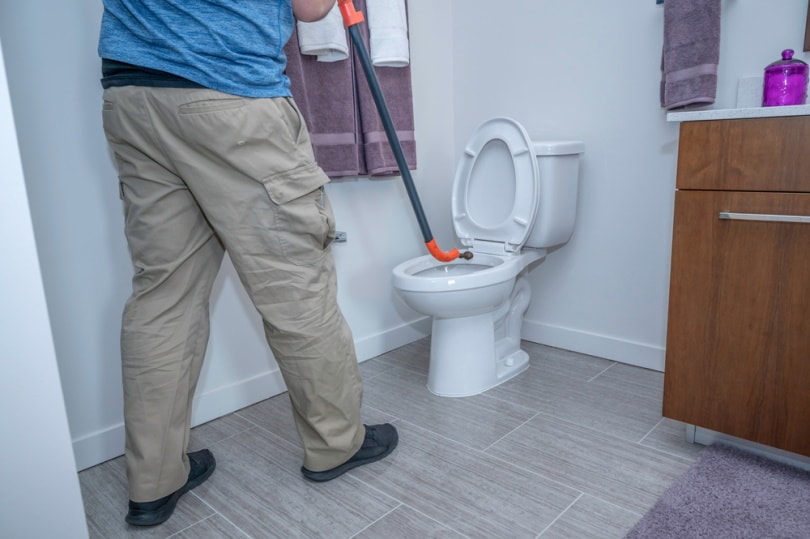How Much Does It Cost to Move a Toilet? (2025 Update)
-

- Last updated:

Remodeling a bathroom is almost always expensive, and costs can ramp up fast when you begin moving pieces around. A toilet alone will typically run over $1,000 to move. The piping has to be precisely measured and pitched as it leaves your home, so even a move of a few inches can disrupt an entire system.
Seeking multiple quotes is essential once you start talking a few thousand dollars (or even a few hundred dollars) in work. Plumbers can approach the job in several ways and provide a broad range of prices. We’ll help you prepare for your bathroom update with this overview of the cost of moving a toilet.
The Importance of Working with a Plumber
Moving a toilet even a few inches can require more than simply cutting a new pipe and connecting it to an existing drain and supply line. The system requires a particular slope, a minimum of ¼ inch drop per foot of pipe run, to drain correctly. It won’t drain if the angle is too shallow, and it could drain too quickly and leave waste behind if it’s too steep.
After accounting for drainage, the water supply line and venting need attention. Among all the chores involved in moving the plumbing around, attaching flexible PEX to pre-existing water supply lines is relatively easy.
The same could be said for the waste-vent line unless you’re moving the toilet a far distance. To be code-compliant, the waste-vent tube must be within a certain distance from any connected P-trap. That could limit how far you move the toilet. Plus, maintaining the proper slope requires more work with a longer drain run to the waste-vent line. You may have to cut the pipe and install a new tee down the vent line to keep the correct angle.
In short moves, the waste-vent and supply lines might not require much more than cutting copper or PVC pipe sections. But they could complicate matters in a structural sense. You may need to worry about running lines through structural components if you’re moving your toilet in a direction perpendicular to your joists and wall studs. The foundation’s integrity is at stake, and you might have to add reinforcement.
Even if you pull all of this off yourself, you still need to worry about code compliance. You don’t want your installation to fail an inspection because you used the wrong elbow or pipe diameter. Working with a professional ensures a proper, safe installation and recourse should anything go awry later.

How Much Does It Cost to Move a Toilet?
Moving a toilet will generally cost $1,000–$3,500 if you need to reroute your lines. The most expensive aspect is changing the drain line, which will begin at roughly $750–$1,000 for materials and labor. Labor can range from $45 to $200 per hour depending on the job’s difficulty, but you can often expect to pay a $70–$120 hourly rate in most situations.
It’s sometimes possible to bypass any intensive plumbing adjustments if you have to move a toilet only a few inches. An offset flange connects to the drain with a 45-degree elbow that pushes the toilet connection a few inches to the side. The part costs about $20 and requires, at most, minor subfloor alterations to work.
| Expected Cost | |
| Toilet Drain Re-Routing Labor | $750–$1,000 |
| Labor Rates | $70–$120/hour |
| Supplies | $150–$200 |
| Equipment Allowance | $40–$60 |
Additional Costs to Anticipate
Rerouting a drain in an accessible area, such as under a ceiling or a crawlspace, runs around $750–$1,000 to start. The task becomes more complicated if you have a slab. You will need to demolish the floor if you need to adjust the plumbing because the piping lies underneath the concrete. Demolishing and rebuilding concrete can get expensive quickly, and it generally costs a few thousand dollars more than if you were moving a toilet over a cavity.
Other potential costs include a new toilet, which will run about $150–$300 or more, and any additional contractor labor. While the former might be optional, you’ll need to replace framing, drywall, paint, and fixtures if you have to move waste-vent lines and ports around in the walls. And no matter what, you will need to redo your flooring and possibly the ceiling underneath if the toilet is on the second floor.
Flooring repair costs may cost under $1,000 if your floor is in good condition and you don’t have to take up much to move your toilet. Additional work on bathroom walls can run about $300–$800, but costs will increase if you need to repair the framing.

How Long Does It Take to Move a Toilet?
Installing a toilet is easy for an experienced DIYer, often taking less than an hour. In moving it several feet, the most time-consuming task is the drain line rerouting.
The plumber will need to take up flooring (or remove the ceiling) and insulation to access the lines. They’ll need to cut the drain line and the new piping to connect the two. The supply line will also require new connections. The entire process, including installation and testing, can take up to 6 hours.
Some remodeling projects may require the drain line to come out and the new drain line to directly fit on the waste vent tube. Worst-case scenarios might even force you to replace the waste-vent line running to the roof. Expect these extra projects to add at least three or more hours to the time and $1,000–$1,500 or more in total expenses.
Does Insurance Cover the Cost to Move a Toilet?
In most instances, your homeowner’s insurance will not cover the cost of moving your toilet. You will pay for any voluntary remodels out of pocket. If you have a covered occurrence, such as a burst pipe, that forces you to make repairs, you may be able to move your toilet on the insurance company’s dime.
When a covered peril destroys your bathroom, you can take the opportunity to move the toilet to a new location. The crucial point to remember is that you will only get compensation for what suffered damage under the terms of your insurance. You must review the extent of your insurance coverage before planning any changes. But keep it within budget, and you can move your toilet anywhere you like!
Conclusion
A toilet isn’t particularly challenging to move, but the roots hidden underneath are the primary concern. It’s easy to overestimate the flexibility in designing your bathroom and underestimate the extent of the work and subsequent costs involved. With an understanding and respect for what even a few inches could mean for your plumbing, you can avoid surprises and set yourself up for a successful bathroom remodel.
Featured Image Credit: rccf.1, Unsplash
Contents

